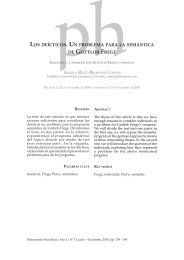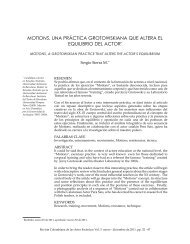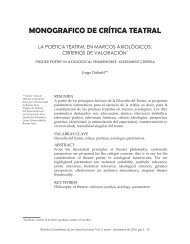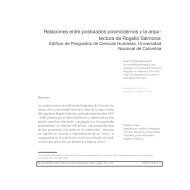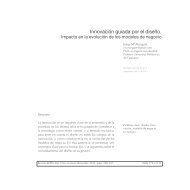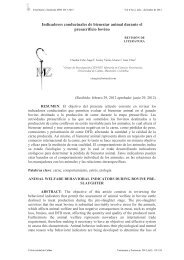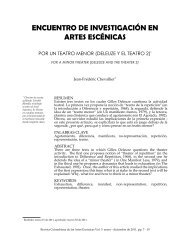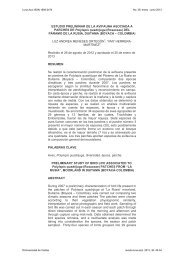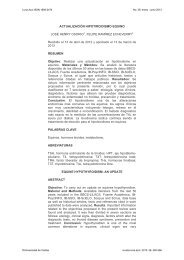Dinámica folicular en la vida reproductiva de la hembra bovina ...
Dinámica folicular en la vida reproductiva de la hembra bovina ...
Dinámica folicular en la vida reproductiva de la hembra bovina ...
You also want an ePaper? Increase the reach of your titles
YUMPU automatically turns print PDFs into web optimized ePapers that Google loves.
Introducción<br />
El <strong>de</strong>sempeño <strong>de</strong> los hatos bovinos está<br />
<strong>de</strong>terminado por <strong>la</strong> efici<strong>en</strong>cia <strong>reproductiva</strong> <strong>de</strong> <strong>la</strong>s<br />
<strong>hembra</strong>s (Oliveira Filho et al., 1999; Webb et al.,<br />
1999; Ma<strong>la</strong>rd et al., 2001). La <strong>vida</strong> <strong>reproductiva</strong><br />
<strong>de</strong> <strong>la</strong> <strong>hembra</strong> <strong>bovina</strong> está marcada <strong>de</strong>s<strong>de</strong> los<br />
inicios <strong>de</strong> su <strong>vida</strong>, es <strong>de</strong>cir, <strong>de</strong>s<strong>de</strong> el <strong>de</strong>sarrollo<br />
fetal <strong>la</strong> <strong>hembra</strong> <strong>bovina</strong> inicia <strong>la</strong> preparación <strong>de</strong><br />
su sistema reproductivo, y al nacimi<strong>en</strong>to órganos<br />
como los ovarios ya ti<strong>en</strong><strong>en</strong> el pot<strong>en</strong>cial para<br />
<strong>la</strong> producción <strong>de</strong> ovocitos cont<strong>en</strong>idos <strong>en</strong> sus<br />
folículos (Roberts, 1971).<br />
En el ovario los folículos son <strong>la</strong> unidad<br />
fundam<strong>en</strong>tal <strong>de</strong>l mismo, y son estructuras<br />
<strong>de</strong>s<strong>en</strong>cad<strong>en</strong>antes <strong>de</strong> los procesos reproductivos y<br />
<strong>de</strong> <strong>la</strong>s fases <strong>de</strong>l ciclo estral. Estos procesos, según<br />
Roberts (1971), están mediados por <strong>la</strong> compleja<br />
interacción <strong>de</strong>l hipotá<strong>la</strong>mo-hipófisis-ovarios a<br />
partir <strong>de</strong> <strong>la</strong> liberación <strong>de</strong> hormonas al torr<strong>en</strong>te<br />
sanguíneo.<br />
La pres<strong>en</strong>te revisión, ti<strong>en</strong>e como objetivo<br />
compr<strong>en</strong><strong>de</strong>r <strong>la</strong> importancia <strong>de</strong> <strong>la</strong> dinámica<br />
<strong>folicu<strong>la</strong>r</strong> <strong>en</strong> <strong>la</strong> <strong>vida</strong> <strong>reproductiva</strong> <strong>de</strong> <strong>la</strong> <strong>hembra</strong><br />
<strong>bovina</strong>, por tanto, se abordan <strong>la</strong>s hormonas<br />
sexuales involucradas <strong>en</strong> el ciclo estral, el papel<br />
<strong>de</strong> los ovarios, el <strong>de</strong>sarrollo embrionario y fetal<br />
<strong>de</strong>l ovario, <strong>la</strong> <strong>en</strong>docrinología <strong>de</strong>l ciclo estral<br />
don<strong>de</strong> se incluye <strong>la</strong> foliculogénesis, <strong>la</strong>s ondas<br />
<strong>folicu<strong>la</strong>r</strong>es, <strong>la</strong>s fases <strong>de</strong>l ciclo estral, a<strong>de</strong>más <strong>de</strong><br />
los mecanismos <strong>de</strong> atresia <strong>folicu<strong>la</strong>r</strong>, <strong>la</strong> acti<strong>vida</strong>d<br />
ovárica <strong>en</strong> <strong>hembra</strong>s prepúberes, púberes, durante<br />
<strong>la</strong> gestación y <strong>en</strong> el periodo postparto.<br />
Hormonas sexuales involucradas<br />
<strong>en</strong> el ciclo estral<br />
La dinámica <strong>folicu<strong>la</strong>r</strong> <strong>en</strong> <strong>la</strong> <strong>hembra</strong> <strong>bovina</strong> es<br />
<strong>de</strong>s<strong>en</strong>cad<strong>en</strong>ante <strong>de</strong> los procesos reproductivos<br />
y <strong>de</strong> <strong>la</strong>s fases <strong>de</strong>l ciclo estral, sin embargo,<br />
estos ev<strong>en</strong>tos están regu<strong>la</strong>dos por un complejo<br />
conjunto <strong>de</strong> factores que se interre<strong>la</strong>cionan y<br />
permit<strong>en</strong> que se pres<strong>en</strong>te <strong>la</strong> ovu<strong>la</strong>ción como punto<br />
final <strong>de</strong>l ciclo estral y punto inicial <strong>en</strong> <strong>la</strong> <strong>vida</strong><br />
<strong>reproductiva</strong> <strong>de</strong> <strong>la</strong> <strong>hembra</strong> <strong>bovina</strong>. Entre estos<br />
Motta Delgado et al.<br />
89<br />
factores juega un papel importante <strong>la</strong> influ<strong>en</strong>cia<br />
<strong>de</strong> <strong>la</strong>s hormonas sexuales involucradas <strong>en</strong> el ciclo<br />
estral, hormonas que se <strong>en</strong>cu<strong>en</strong>tran regu<strong>la</strong>das por<br />
el sistema neuro<strong>en</strong>docrino <strong>de</strong>l eje hipotá<strong>la</strong>mohipófisis-ovarios-útero.<br />
Para Arthur (1975) y Rathbone et al. (2001), los<br />
ciclos reproductivos y sus cambios están regu<strong>la</strong>dos<br />
por <strong>la</strong> interacción <strong>de</strong>l sistema nervioso c<strong>en</strong>tral con<br />
<strong>la</strong>s hormonas <strong>de</strong> <strong>la</strong> glándu<strong>la</strong> pituitaria anterior y<br />
los ovarios. Para Callejas (1995), los estímulos<br />
<strong>de</strong>l medio externo, actúan sobre estructuras<br />
nerviosas extrahipotalámicas como <strong>la</strong> glándu<strong>la</strong><br />
pineal que a su vez ejerc<strong>en</strong> un efecto <strong>de</strong> estímulo<br />
sobre el hipotá<strong>la</strong>mo, el cual <strong>en</strong> sus neuronas<br />
se <strong>en</strong>carga <strong>de</strong> <strong>la</strong> producción <strong>de</strong> <strong>la</strong> hormona<br />
liberadora <strong>de</strong> gonadotropina (GnRH) que, según<br />
C<strong>la</strong>rke (1988), es liberada <strong>en</strong> forma <strong>de</strong> pulsos.<br />
Según Arthur (1975), C<strong>la</strong>rke (1988) y Callejas<br />
(1995), <strong>la</strong> GnRH <strong>en</strong> <strong>la</strong> emin<strong>en</strong>cia media, difun<strong>de</strong><br />
a los capi<strong>la</strong>res <strong>de</strong>l sistema portahipofisiario y<br />
<strong>de</strong> allí hasta <strong>la</strong>s célu<strong>la</strong>s <strong>de</strong> <strong>la</strong> ad<strong>en</strong>ohipófisis <strong>en</strong><br />
don<strong>de</strong> estimu<strong>la</strong> <strong>la</strong> síntesis <strong>de</strong> <strong>la</strong> hormona folículo<br />
estimu<strong>la</strong>nte (FSH) y <strong>la</strong> hormona luteinizante<br />
(LH), hormonas relevantes <strong>en</strong> el control <strong>de</strong>l<br />
ciclo estral porque, según Arthur (1975), actúan<br />
sobre el ovario y causan <strong>la</strong> maduración <strong>de</strong>l<br />
folículo y secreción <strong>de</strong> estróg<strong>en</strong>o. Para Callejas<br />
(1995), <strong>la</strong> FSH es <strong>la</strong> responsable <strong>de</strong>l proceso<br />
<strong>de</strong> esteroi<strong>de</strong>génesis (<strong>folicu<strong>la</strong>r</strong>) “producción<br />
<strong>de</strong> estróg<strong>en</strong>os”, crecimi<strong>en</strong>to y maduración <strong>de</strong>l<br />
folículo dominante; <strong>la</strong> LH está involucrada <strong>en</strong> el<br />
proceso <strong>de</strong> esteroi<strong>de</strong>génesis (luteal) “liberación<br />
<strong>de</strong> progesterona”, ovu<strong>la</strong>ción, formación y<br />
mant<strong>en</strong>imi<strong>en</strong>to <strong>de</strong>l cuerpo lúteo. Estas dos<br />
hormonas son secretadas a <strong>la</strong> corri<strong>en</strong>te sanguínea<br />
por medio <strong>de</strong> pulsos que varían <strong>en</strong> frecu<strong>en</strong>cia y<br />
amplitud (Hauger et al., 1977; Rahe et al., 1980;<br />
Wright & Malmo, 1992), y son regu<strong>la</strong>das por el<br />
sistema tónico y cíclico ubicado <strong>en</strong> el hipotá<strong>la</strong>mo.<br />
Según Callejas (1995), el sistema tónico produce<br />
el nivel basal circu<strong>la</strong>nte, siempre constante <strong>de</strong><br />
hormonas hipofisiarias <strong>en</strong>cargadas <strong>de</strong>l <strong>de</strong>sarrollo<br />
<strong>de</strong> los elem<strong>en</strong>tos germinales y <strong>en</strong>docrinos <strong>de</strong>l<br />
ovario. El sistema cíclico es <strong>de</strong> función aguda,<br />
si<strong>en</strong>do activo solo 12 a 24 horas <strong>en</strong> cada uno<br />
<strong>de</strong> los ciclos reproductivos <strong>de</strong> <strong>la</strong>s <strong>hembra</strong>s<br />
“g<strong>en</strong>eralm<strong>en</strong>te <strong>en</strong> el estro”. El modo cíclico ti<strong>en</strong>e<br />
vet.zootec. 5(2): 88-99, 2011



